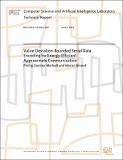Value-Deviation-Bounded Serial Data Encoding for Energy-Efficient Approximate Communication
Author(s)
Stanley-Marbell, Phillip; Rinard, Martin
DownloadMIT-CSAIL-TR-2015-022.pdf (31.59Mb)
Other Contributors
Program Analysis and Compilation
Advisor
Martin Rinard
Metadata
Show full item recordAbstract
Transferring data between ICs accounts for a growing proportion of system power in wearable and mobile systems. Reducing signal transitions reduces the dynamic power dissipated in this data transfer, but traditional approaches cannot be applied when the transfer interfaces are serial buses. To address this challenge, we present a family of optimal value-deviation-bounded approximate serial encoders (VDBS encoders) that significantly reduce signal transitions (and hence, dynamic power) for bit-serial communication interfaces. When the data in transfer are from sensors, VDBS encoding enables a tradeoff between power efficiency and application fidelity, by exploiting the tolerance of many of the typical algorithms consuming sensor data to deviations in values. We derive analytic formulations for the family of VDBS encoders and introduce an efficient algorithm that performs close to the Pareto-optimal encoders. We evaluate the algorithm in two applications: Encoding data between a camera and processor in a text-recognition system, and between an accelerometer and processor in a pedometer system. For the text recognizer, the algorithm reduces signal transitions by 55% on average, while maintaining OCR accuracy at over 90% for previously-correctly-recognized text. For the pedometer, the algorithm reduces signal transitions by an average of 54% in exchange for step count errors of under 5%.
Date issued
2015-06-04Series/Report no.
MIT-CSAIL-TR-2015-022